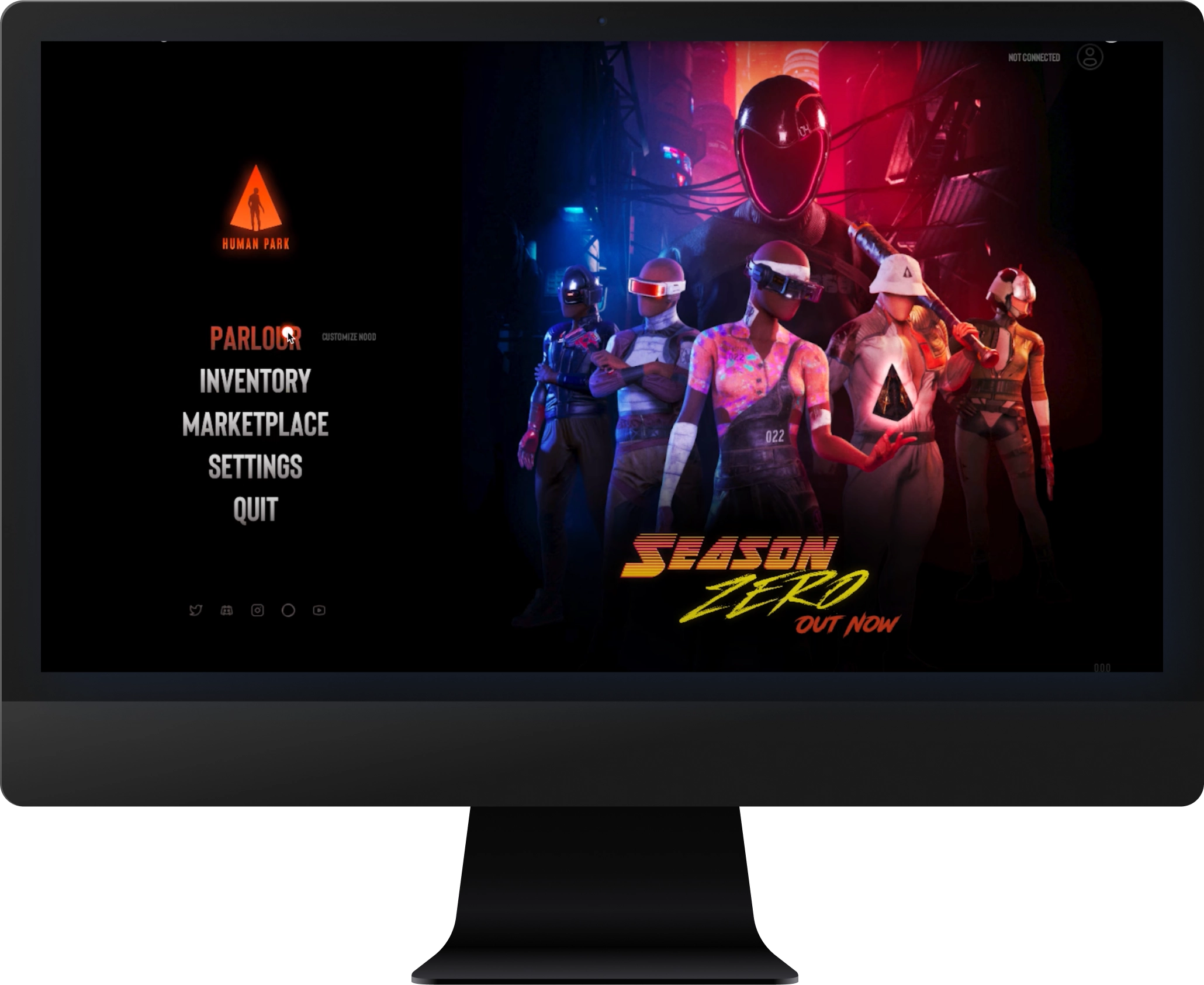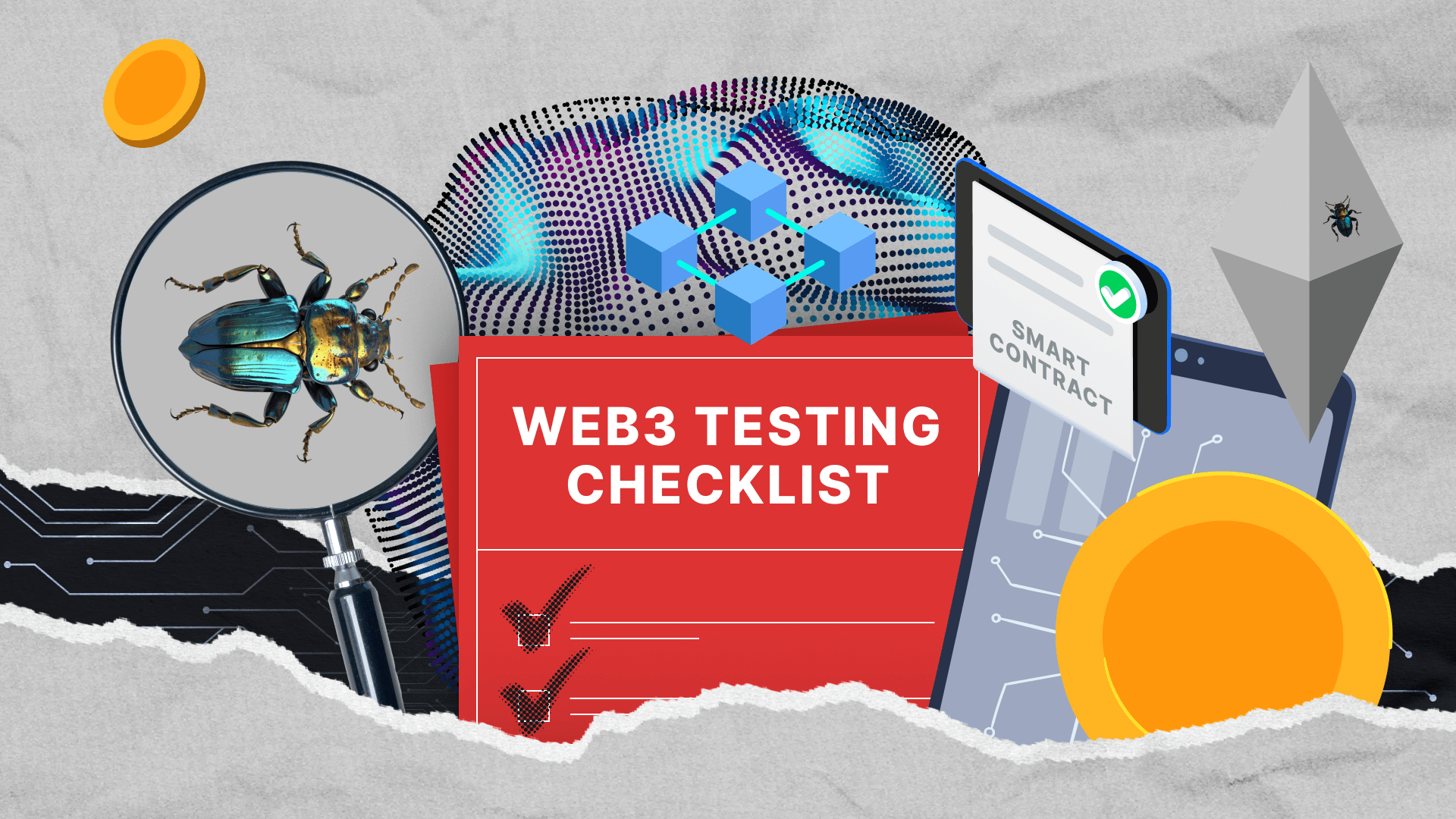Web3 apps are becoming more popular as businesses and developers look to leverage the benefits of blockchain technology. However, testing web3 apps can be complex due to the unique characteristics of blockchain technology, such as decentralization, immutability, and security.
This checklist provides a comprehensive set of guidelines for QA engineers and developers to test web3 apps. It covers a wide range of testing areas, including functionality, security, performance, and usability. By following this checklist, web3 delivery teams can ensure that their apps are high-quality and meet the needs of their users.
Web3 Testing Checklist
To test web3 apps effectively, QA engineers need to understand web3. This means knowing about blockchain, smart contracts, decentralized apps, decentralized data storage, and peer-to-peer networking. By understanding how these aspects work together, QA engineers can create better test cases, find potential problems, and make top-notch web3 apps.
At QAwerk, we’ve been helping companies with software quality since 2015. We want to share our unique knowledge about auditing web3 apps. Our guide will teach you about how to secure your blockchain-based app and deliver fantastic user experiences.
Smart Contract Testing
Smart contracts are the backbone of many web3 applications, providing a secure and transparent way to automate agreements between parties. A bug in a smart contract can result in significant financial and reputational losses. Case in point, Qubit Finance, a decentralized finance (DeFi) platform that lost $80 million in crypto due to a bug in its smart contract.
Public blockchains like Ethereum are inherently immutable, meaning smart contract code cannot be altered once deployed. While techniques exist to “virtually upgrade” contracts, these methods are complex and require careful planning as well as coordination. Moreover, upgrades can only address vulnerabilities after they’ve been identified. For these reasons, testing smart contracts before deployment on a mainnet is a fundamental requirement. It helps ensure that the contract functions as intended and is resistant to attacks.
Functional Correctness:
- Ensure smart contracts correctly handle a variety of inputs, including boundary cases and invalid data, to prevent unexpected behavior
- Test each function in the contract for logical correctness to ensure that the outcomes match the specified requirements
- Validate that state transitions within the contract are consistent and accurate, particularly in response to different transaction types and conditions
Security and Vulnerability Checks:
- Actively test for known security vulnerabilities like reentrancy attacks, integer overflows/underflows, and race conditions
- Simulate attacks on the smart contract to identify potential security weaknesses or possible exploits
- Perform thorough code reviews and audits to ensure adherence to security best practices and identify hidden vulnerabilities
Gas Usage and Optimization:
- Analyze and optimize gas usage for contract execution, focusing on reducing costs without compromising functionality
- Conduct stress tests to identify and resolve instances of excessive gas consumption under various scenarios
- Implement accurate gas estimation mechanisms to prevent out-of-gas errors during contract execution
Upgradeability and Modularity:
- Test upgrade mechanisms to ensure they don’t introduce vulnerabilities or disrupt existing functionalities
- Confirm that the contract’s modular design facilitates easy updates and maintenance
- Ensure new versions remain compatible with previous versions, preserving data integrity and contract functionality
State Consistency and Persistence:
- Regularly verify that the contract maintains a consistent state across transactions and interactions
- Test the contract’s ability to reliably store and retrieve data, even under adverse network conditions
- Evaluate the contract’s behavior and resilience in the event of blockchain forks
Inter-Contract Interaction and Dependencies:
- Examine the contract’s interactions with other contracts, ensuring correct data exchange and function calls
- Assess how the contract handles external dependencies and whether these dependencies impact its performance or security
- Test the contract within the broader system context, considering how it integrates with and affects other system components
Compliance with Standards:
- Verify compliance with relevant blockchain standards (e.g., ERC-20 for tokens) to ensure interoperability and consistency
- Evaluate the contract’s alignment with industry best practices and community guidelines to foster trust and acceptance
Decentralized Application (Dapp) Testing
Dapps are the practical manifestation of web3. They demonstrate the potential blockchain technology has to create new types of applications that are more secure, transparent, and user-centric.
At the same time, Dapps can be more vulnerable to security breaches than traditional web apps. Smart contracts can have hidden flaws if not carefully designed and tested. Unlike conventional apps, Dapps lack a central authority to oversee security, making it harder to spot and fix threats. However, by following industry standards and testing thoroughly, developers can significantly reduce these risks.
User Interface and Experience:
- Verify that the Dapp’s user interface remains consistent and responsive across different devices and screen sizes
- Test the ease of navigation and overall usability of the Dapp, ensuring users can intuitively interact with the application
- Check that the Dapp provides clear feedback and error messages, guiding users effectively through their interactions

Transaction Handling and Blockchain Interaction:
- Test the Dapp’s ability to execute blockchain transactions accurately, including creating, signing, and confirming transactions
- Ensure the Dapp correctly handles blockchain events, such as block confirmations and smart contract triggers
- Verify that the Dapp updates its state in real-time in response to blockchain changes, maintaining data accuracy and consistency
Smart Contract Integration:
- Confirm that the Dapp interacts correctly with smart contracts, including sending and receiving data
- Test that the Dapp’s functionality aligns with the underlying smart contract logic and intended use cases
- Evaluate the Dapp’s ability to handle smart contract errors or exceptions gracefully, without compromising user experience
Security Testing:
- Check that the Dapp properly validates and sanitizes user inputs to prevent attacks such as SQL injection or cross-site scripting (XSS)
- Test the security mechanisms for user authentication and authorization, ensuring robust access controls
- Assess the Dapp’s data privacy measures, including the use of encryption for sensitive information

Performance and Scalability:
- Conduct load testing to evaluate the Dapp’s performance under high user traffic and transaction volume
- Check for efficient resource usage, such as minimizing network requests and optimizing on-chain interactions
- Test the Dapp’s scalability, ensuring it can handle growth in users and transactions without performance degradation
Cross-Platform and Cross-Browser Compatibility:
- Verify that the Dapp functions correctly across various platforms (e.g., Windows, macOS, Linux) and browsers (e.g., Chrome, Firefox, Safari)
- Ensure that the Dapp’s design and layout adapt seamlessly to different devices and screen sizes
- Test for consistent feature availability and functionality across different platforms and browsers

Network and Connectivity Testing:
- Evaluate the Dapp’s ability to handle network issues, such as slow or interrupted connections
- Test any offline capabilities of the Dapp, ensuring it provides a seamless experience even without continuous connectivity
- Check for effective fallback mechanisms in case of network failures or blockchain unavailability

Blockchain Testing
Blockchain testing is crucial for ensuring the reliability and security of your web3 application. This involves verifying that transactions are processed correctly, that the consensus mechanism is functioning as expected, and, if applicable, that the Dapp can interact seamlessly with other blockchains.
Block and Transaction Validation:
- Test the process of block creation and validation to ensure blocks are correctly formed and verified according to network rules
- Verify the accurate processing of transactions, including validation, confirmation, and recording on the blockchain
- Check the blockchain’s mechanisms for preventing double spending to maintain the integrity of the transaction ledger
Consensus Mechanism Testing:
- Test whether the consensus mechanism (e.g., Proof of Work, Proof of Stake) operates as intended and adheres to protocol specifications
- Evaluate the blockchain’s ability to maintain consensus despite faulty or malicious nodes
- Assess how the consensus mechanism handles network delays and forks, ensuring stability and consistency
Network Security and Resilience:
- Conduct penetration testing to identify potential security vulnerabilities within the blockchain network
- Test the resilience of individual nodes and the overall network to attacks and failures
- Verify the strength and implementation of cryptographic algorithms used for securing data and transactions
Smart Contract and Dapp Integration:
- Ensure seamless integration of smart contracts and Dapps with the blockchain, including data synchronization and event handling
- Test interoperability between different blockchain platforms and layers, if applicable
- Validate the deployment process of smart contracts and their correct execution within the blockchain environment
Performance and Scalability:
- Measure the blockchain’s transaction throughput and processing speed under various loads
- Evaluate the blockchain’s ability to scale with an increasing number of nodes, transactions, and users
- Assess the efficiency of resource utilization, including computation, storage, and network bandwidth
Data Integrity and Storage:
- Check for the accuracy and integrity of data stored on the blockchain, including blocks and transaction records
- Test the system’s redundancy measures and its ability to recover from data loss or corruption
- Evaluate the efficiency of data storage mechanisms, especially in the context of growing blockchain size
Network Protocols and P2P Communication:
- Test the implementation and adherence to network protocols governing node communication and data transmission
- Assess the robustness and reliability of peer-to-peer communication within the blockchain network
- Examine the speed and efficiency of message propagation across the network, ensuring timely and accurate dissemination of information
User and Access Control:
- Test mechanisms for user authentication and access control within the blockchain network
- Verify that role-based access controls function correctly, providing appropriate permissions and restrictions
- Ensure that the blockchain maintains accurate and comprehensive audit trails for accountability and traceability
Wallet Integration Testing
A well-integrated wallet enhances the user’s journey by providing an intuitive experience. Users should be able to connect their wallets effortlessly and interact with Dapps without friction. Wallet integration testing helps identify potential security vulnerabilities, such as unauthorized access or transaction failures. Also, different wallets have varying features and interfaces. Wallet integration testing ensures that your Dapp works well with a wide range of wallets, accommodating diverse user preferences.
Compatibility and Connectivity:
- Test the integration with a variety of wallets (e.g., MetaMask, Trust Wallet, Ledger) to ensure broad compatibility
- Verify stable and reliable connections between the application and wallets, including reconnection handling after disruptions
- Ensure wallet integrations function correctly across different platforms and devices
Transaction Processing:
- Test the process of initiating transactions from the application and correctly signing them in the wallet
- Verify that transactions are properly broadcasted to the blockchain network after wallet approval
- Check the application’s handling of transaction confirmations and receipts, ensuring accurate reflection of transaction status
Security and Authorization:
- Confirm that private keys are managed securely within the wallet and never exposed to the application or external entities
- Test the robustness of authorization mechanisms for transaction approval, ensuring that unauthorized transactions are prevented
- Verify encryption of sensitive data transmitted between the application and the wallet

User Interface and Experience:
- Ensure that wallet integration is seamless and intuitive, providing a smooth user experience without unnecessary complexities
- Check for effective error handling and clear messaging when wallet interactions fail or encounter issues
- Provide clear instructions and guidance for users on how to connect and use their wallets within the application
Smart Contract Interaction:
- Test the ability of the wallet to interact with smart contracts, including executing functions and querying data
- Verify that the wallet accurately estimates gas fees and allows users to adjust these fees when necessary
- Ensure that the wallet and application correctly handle events emitted by smart contracts
Performance and Reliability:
- Measure the response times for wallet operations, ensuring they are within acceptable limits for a good user experience
- Conduct load testing to evaluate the performance of wallet integrations under high transaction volumes and user concurrency
- Test fallback mechanisms in case of wallet service disruptions or failures
Cross-Wallet Functionality:
- Assess the interoperability of wallet integrations with different blockchain networks and tokens
- Ensure consistent functionality across different wallets, including features like token transfers, contract interactions, and NFT handling
- Test the application’s handling of network switching in multi-chain wallets, verifying correct network detection and interaction
Regulatory and Compliance Considerations:
- Verify that wallet integrations comply with relevant regulatory requirements, including KYC (Know Your Customer) and AML (Anti-Money Laundering) where applicable
- Assess how the integration respects user privacy, particularly in terms of data collection and sharing
- Ensure that the integration adheres to legal standards and guidelines related to cryptocurrency transactions and wallet usage
Cross-Chain Functionality Testing
By enabling interoperability, businesses can tap into a wider user base across various blockchain ecosystems. Cross-chain testing verifies that applications can operate effectively across different blockchain networks, protecting users’ assets and reputation. Don’t repeat the mistakes of Orbit Chain: they lost $81 million due to a cross-chain bridge exploit.
Interoperability and Compatibility:
- Test the ability of the application to communicate and interact with multiple blockchain platforms, verifying data exchange and transaction processing
- Ensure compatibility with different blockchain protocols and standards, checking for seamless operation across various chains
- Verify the functionality of cross-chain asset transfers, including tokens and digital assets, ensuring accuracy and security
Smart Contract Bridging:
- Test smart contract interactions across chains, including calling functions and accessing data
- Ensure that smart contract execution is consistent and reliable when interacting with different blockchains
- Assess the security of bridge contracts or mechanisms used for cross-chain interactions, focusing on preventing vulnerabilities and exploits
Transaction Finality and Reconciliation:
- Test for transaction finality on different chains, ensuring that transactions are confirmed and irreversible once completed
- Verify the processes for reconciling transactions across chains, ensuring data consistency and accuracy
- Evaluate mechanisms in place for handling disputes or inconsistencies arising from cross-chain transactions
Network Latency and Synchronization:
- Assess the impact of network latency on cross-chain interactions, particularly for time-sensitive operations
- Test the synchronization of data across chains, ensuring timely and accurate updates
- Check how the application handles blockchain events occurring on different chains, maintaining consistency in responses
Performance and Scalability:
- Measure the throughput of cross-chain operations, ensuring they can handle the desired transaction volume
- Evaluate the scalability of cross-chain functionality, particularly as the number of supported chains increases
- Test for efficient use of resources in cross-chain operations, such as computational power and network bandwidth
User Experience and Interface:
- Ensure that the user interface provides a seamless experience for cross-chain interactions, minimizing complexity and confusion
- Verify that the application clearly communicates the cross-chain nature of operations to users, including any implications or risks
- Test the application’s error handling and user guidance for cross-chain operations, providing clear instructions and feedback
Security and Trust Mechanisms:
- Test the security protocols in place for cross-chain operations, ensuring robust protection against attacks and fraud
- Assess systems for establishing trust and verifying transactions across chains, including consensus mechanisms and validation processes
- Verify that comprehensive audit trails and logs are maintained for cross-chain operations, aiding in transparency and traceability
Case Studies: Our Web3 Expertise
Here at QAwerk, we’ve been helping companies build high-performing software since 2015. Our expertise extends to the exciting world of web3, where we use our knowledge to ensure the security and functionality of your blockchain-based apps.
Web3 Gaming Platform
Virtually Human Studio, the creators of the popular blockchain horse racing game ZED RUN, partnered with QAwerk to test their new web3 game, Human Park. When we joined the Human Park project, the platform was still under development. Our QAwerk team focused on ensuring a positive user experience for early adopters.
We rigorously tested the installation, wallet integration, and avatar creation process. We used exploratory testing to understand the game from a new player’s perspective and conducted regression testing to maintain code quality. Our efforts helped Human Park deliver a seamless experience for the 30,000 waitlisted users, contributing to their successful launch and building of an engaged community.
Web3 Messenger
Our experience extends beyond Human Park. We’ve also successfully tested Tingl, a blockchain-based messenger designed for anonymity. To ensure the quality and security of an app like Tingl, a comprehensive testing approach is essential.
With functional testing, we verified core features, group chats, file sharing, and payment integration. Our security testing focused on end-to-end encryption, data privacy, phishing resistance, and smart contract security. Thanks to performance testing, we evaluated load, latency, and scalability. Blockchain-specific testing covered the smart contract interactions, consensus mechanisms, and network congestion. Finally, we conducted usability testing to ensure a user-friendly interface and experience.
Crypto Wallets & Exchanges
At QAwerk, we also have experience with testing crypto wallets, exchanges, portfolio trackers, and trading platforms. We’ve tested over 100 of these apps for free within our Bug Crawl program.
Some of the notable names we’ve helped include Binance, Blockchain.com, ZenGo, Cryptohopper, CoinZoom, and CoinTracker. By partnering with QAwerk, you gain access to this wealth of experience and a team dedicated to safeguarding your web3 projects.
Launching a web3 app can be stressful. Let us take some of that pressure off of your team. Contact us today to learn how our web3 testing expertise can help you release a successful and secure app.
See how we helped Virtually Human bug-proof their web3 platform for 30,000+ early adopters


